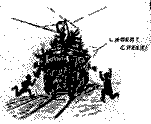|
|
IT was
one of those perfect spring days that inspire birds
with song and men with spring fever. Suddenly there
was a sound of music (more clamorous than
harmonious) that echoed even unto the most secret
recesses of the Campus. Immediately order was
changed to pandemonium. Professors strove to hold
the attention of listless classes; wailings and
strange mutterings filled the air; curious faces
peered out of windows. The chief of goblins, who
has maintained his tyrannical sway from the old
tower of U hall for over forty years, sought safety
in the attic below. Then a brief silence, after
which the music again broke forth, followed by a
random of yells that proclaimed to the University a
legal holiday (legal in every sense), the annual
barbecue of the Law College.
But soon all was quiet; nothing
remained of the disturbance except the resentment
it had caused. At Capital Beach the fatted calf of
three summers had been slain and roasted -- a
wonderful banquet it was, and great was the eating
thereof. In less than an hour Dr. Maxey rivaled
President Taft in circumference. Dignity was
forgotten; and embryo attorneys, professors, famous
lawyers, and judges mingled together as one great
family. There were speeches, songs, jokes, and
hand-shakes, without number.
|
 Then
came the great athletic carnival. Some were
contesting in boats while others bathed in the
briny waves of the lake; there were marvelous feats
in baseball. The married men ran a race. Professor
Conant madly was waving his coat as John Munday
crossed the tape in the lead. Dean Hastings gave
his sacred beard an unkind twist. Professor Robbins
shouted for joy, and, forgetful of his prejudice
threw his arms about the neck of a justice of the
Nebraska supreme court. Effeminate Clark Johnson
actually forgot to think about the ladies for a
small fraction of a second (the first time in ten
years). Even Sam Buck began to show signs of
activity -- and who will doubt that great miracles
had been wrought that day? Then
came the great athletic carnival. Some were
contesting in boats while others bathed in the
briny waves of the lake; there were marvelous feats
in baseball. The married men ran a race. Professor
Conant madly was waving his coat as John Munday
crossed the tape in the lead. Dean Hastings gave
his sacred beard an unkind twist. Professor Robbins
shouted for joy, and, forgetful of his prejudice
threw his arms about the neck of a justice of the
Nebraska supreme court. Effeminate Clark Johnson
actually forgot to think about the ladies for a
small fraction of a second (the first time in ten
years). Even Sam Buck began to show signs of
activity -- and who will doubt that great miracles
had been wrought that day?
When the last slanting rays of
the setting sun glanced across the lake the
homeward journey was begun -- so tired, but after
all how grand
|
|





